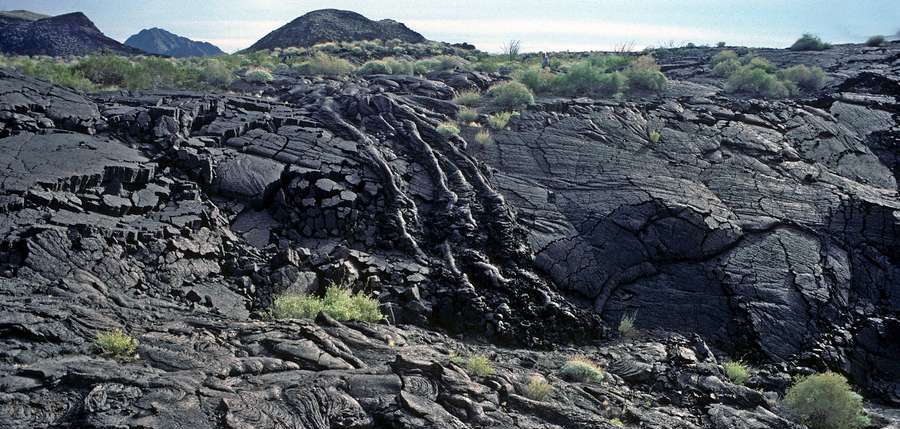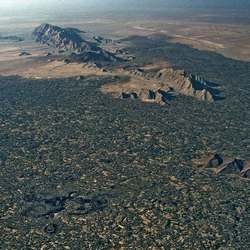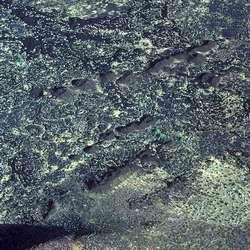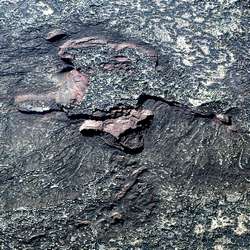

The Ives flow, a little bit of Hawaii
Flujo de Ives is pahoehoe; basalt with a smooth, shiny surface whose magma moved internally through tubes beneath a surface which shifted very little after it had formed. The distinctive ropy, billowy pahoehoe surface is found on other Pinacate lavas, most notably at Carnegie, but Ives is the only flow almost entirely smooth surface. Ives is unique in other ways; it has spatter ramparts at some conduits but not even a minor cone, its volume is two orders of magnitude larger than any other Pinacate lava flow - possibly half a cubic kilometer, and it is a tholeiite in a field of alkali olivine basalts. It's a lot like the lavas of Hawaii.
Ives magma poured copiously from a 3.5 km long set of N-S fissures that opened at 200 m elevation near the base of Santa Clara. Lines of spatter ramparts formed along the smaller, less productive fissures while the bulk of the magma appears to have come through the southernmost fissure that is buried beneath an ordinary surface. The lava flowed toward the east but also toward the south where it split around the Sierra Blanca, one branch going north of the mountains and the other west, that branch stopping 13 km from its source to make a good base for the visitor's center.
In addition to the vent top spatter cones, Ives produced a variety of surface features - classic festoon folding, tumuli with central cracks, hornitoes, even some tiny areas of autobrecciated aa. The main fissure has two subsidence craters ("pits of terror y espanto" according to the diary of Juan Matteo Manje) and possibly a spatter mound. Terror (my name), the largest pit, includes a field of shelly pahoehoe, a spatter cone, and several lava tube caves. Ives has a large sag-flowout where one of the lava tubes drained and its roof collapsed into the open space (header image).
Although the shiny surface is extensively weathered, Ives is clearly of recent origin. An age of 13 ± 3 thousand years has been determined using the argon-argon dating technique. I named this flow for Ronald L. Ives, first scientist to systematically study Pinacate in detail.

An overview
Ives, seen from the air, has a mottled appearance quite unlike any of the other Pinacate flows. Its surface is solid and the sand blown east from the adjacent Gran Desierto has “ponded” in the low areas between the pahoehoe billows and tumuli. Not much has been carried into the interior of the flow. In contrast, sand that falls on rough surface lavas gets washed down between the rocks and will not appear on the surface until the roughness has been completely filled-in.This gallery of images shows a long view of Ives. Google Earth images of Ives in 2012 are soft focus. Microsoft/Yahoo Flashearth has sharper images whose usefulness is undermined by the restricted tonal range.

A field of fissures
Parallel lines of spatter cones and spatter ramparts formed along four or five minor fissures on the northern edge of Ives. These fissures produced the pahoehoe that surrounds them as well as the matte-black aa within the pahoehoe. The spatter was produced by gas activity, possibly toward the end of the eruption. Most of the vents are along this line of fissures except for two craters at the base of an old, "kipuka" cone 500 m to the west.
Pit craters on the main fissure
Terror, the largest of the subsidence craters on the main fissure, is a complex pit crater. I think it formed at the end of the eruption when the weight of magma in the conduit had balanced the hydrostatic pressure in the magma chamber. Magma ceased to pour from the conduit but gas continued to exsolve from it, form bubbles, and rise to the surface. "Cow-pie" spatter litters the lava surface around this pit. The degassing magma in the conduit shrank, dropping the pit floor.Ordinary pahoehoe can be seen in the pit and surrounding it in the upper, lower, and right side of this photograph. The material on the left and also surrounding the cliffs is "shelly pahoehoe," some of the most dangerous lava to walk on .
A matter of time
Potassium becomes argon by radioactive decay and measuring these elements has provided a useful geological clock for half a century. The clock is based on three assumptions; that the K and Ar can be reliably measured, that the rock contains no radiogenic Ar when it cools, and that it has neither gained nor lost radiogenic Ar since that event. Nearly one percent of the air we breathe is radiogenic argon produced over the 5-billion-year age of the earth and weathered out of the rocks but careful work can eliminate this noise and the K-Ar clock provides consistent results.In the olden days (my days) K and Ar were measured separately. Tens of grams of rock had to be melted in a vacuum furnace because the mass spectrometers were not precise and needed a lot of argon. The modern Ar-Ar technique does not measure K directly but converts the isotope 39-K in a nuclear reactor to 39-Ar as a proxy. Tiny quantities of 39-Ar and 40-Ar are measured simultaneously in far more precise mass spectrometers as a laser heats individual crystals in steps. Geochronologist Brent Turrin, playing his mass spectrometer like Yo Yo Ma plays his cello, teased out a number for the potassium-poor Ives tholeiite of 13 ± 3 Ka (thousand years), miraculous yet perfectly reasonable.